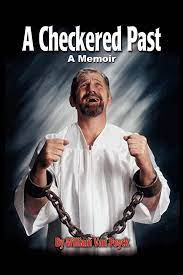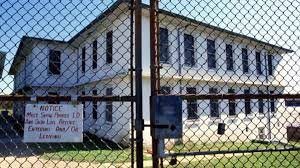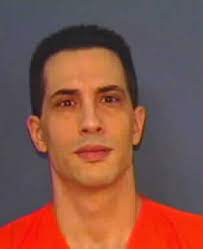
In my last article, I discussed how my authorial career has been a process of evolution, leading ultimately to my recently completed work of creative, narrative or literary – they all mean the same – nonfiction. A secondary character in that plot, the partner in crime of a primary character, aroused my interest as much as did any of them. He personified Darwin’s dictum “survival of the fittest,” associated with the biologist’s theory of natural selection.
His name was William Van Poyck, and he, even more than his criminal collaborator, Frank Valdes, was a compelling figure whose tragic life followed a predictive, yet awesome, path. How do I know this? In poring through voluminous documents in the discovery route to production of the aforementioned nonfiction manuscript, titled LITTLE RAG DOLL: The Story of Wanda, I learned that, during his 26 years on death row, he penned several books and a volume of short stories. His memoir, A Checkered Past, won first place in a Writer’s Digest competition, and one of the stories also won an award.
The memoir is the most riveting book I have ever read. From age two, when his mother died, to his last criminal act at age thirty-two, his life resembled not so much a roller-coaster ride as a leaf in a hurricane, tossed helter-skelter in the frenzied winds and coming to rest only briefly as the eye of the storm passed. His father, a World War II hero who was crippled from a bomb explosion, was an executive with Eastern Airlines, a job that had him traveling extensively. The four children of the widower were reared by a series of abusive housekeepers, the last of whom beat them daily.

His father absent most of the time, William worships his older brother, Jeff, who rewards him with bullying that includes holding little Billy’s head under water until he almost passes out. Jeff, a cat burglar of rich homes, lectures him on upholding the family’s glorious ancestral Teutonic heritage as noblemen and warriors, and Bill continually puts himself in situations that test his courage. At age seven or eight, he walks into a smoldering pile of construction debris and shrubbery, the ashes covering burning embers. Suddenly, the searing pain hits him, and he runs out screaming, his skin peeling off. He is hospitalized for several months.
Before that, he comes upon a house covered in a huge tent, bearing warning signs that poisonous chemicals are inside. He holds his breath and enters several times, carrying out dishes of the poison and ransacking the premises. He and sister Lisa then go on a burglary spree.
Bill, Jeff and Lisa run away from home repeatedly, and a juvenile officer finally tells the court they must be removed from the home. Bill and Lisa are sent from one juvenile home to another, until he lands at the Okeechobee School for Boys. Counselors delight in beating the boys with straps and paddles, requiring them to lie on a steel bed and hold onto iron posts. If they cry out or let hold of a post, the beating starts again. Bill experiences excruciating pain, and he other boys escape from the home, and are later captured.
Finally at home, attending high school, he needs to earn spending money and buy a car, since his dad won’t grant an allowance. In desperation, he accepts a pistol from another teenager in a counseling group, and robs a restaurant. With the loot, he goes on a car-theft rampage, and is caught. His dad gets him released pending charges, and he decides to flee to California and be with Lisa, who has earlier found her way there. He’ll need money, and pulls off an armed robbery, but again is arrested. This time, he faces Judge Alfonso Sepe, famous for handing down maximum sentences, and later removed from the bench for going light on a defendant in exchange for sex with his wife. Sepe sentences Van Poyck, age seventeen, to life in prison.
At the Sumter institution in central Florida, Van Poyck quickly perceives the gulf between the boys school and this den of seasoned, hardened criminals, and repeatedly is caught up in violence. He witnesses the murder of a nineteen-year-old, innocent fellow in for marijuana possession. Several inmates participate in stabbing him to death – for the thrill of it. After a half-hour, medical technicians finally saunter up, laughing and joking as he lay dying, and pronounce him dead.

A full-scale race riot breaks out, and Van Poyck fashions a zip gun afterward to defend himself from further mayhem. He is caught, and shipped to the most notorious prison in Florida, the Rock in Starke, and after an incident there, to the even more violent East Unit. An inmate teaches him to feign insanity, and he is sent to the Chattahoochee State Hospital, where drugs with terrifying effects are administered. Then he is transferred to a much gentler facility in Sebring, but manages to escape and hops a freight train to St. Petersburg. He steals a car and drives to West Palm Beach, where he meets an old prison mate, who tells him about a jewelry store owner in Detroit where a lot of cash and drugs are stashed. There, he runs into several former mates, who betray him, and he is arrested.
Back at the East Unit, he is in the workout room when a 272-pound barbell breaks. On a lark, he and another legally savvy inmate write a letter to the manufacturer, then file a lawsuit. They discover that 7,500 defective barbells have been sold worldwide, and the case expands. Lawyers plead with prison officials to do something to stop Van Poyck and his legal partner, O.B., and they are transferred to the prison in Belle Glade. The lawsuit progresses, and the two are offered $2,500 each to settle. They are granted a lot of freedom at the prison, and Van Poyck is paroled shortly afterward. He knows that his friend O.B. is legally entitled to a new trial, but the court twists the facts, and Van Poyck promises to get him out.
But Van Poyck again gets into trouble, and is sent to the Dade Correctional Institution, where he watches Frank Valdes win a vicious fistfight. Van Poyck is exonerated and released again on parole, after fifteen years in prison. He tries to recall how many murders he has personally witnessed during that time, by knife, razor, pipe, zip gun, bat, rope, lighter fluid – and loses count at about twenty.

On the outside, he’s given a job, but it’s not enough to pay the bills even with bare-bones budgeting. Soon, he is assisting drug smugglers, then teaming with Frank Valdes, who also has won parole, in robbing banks. Van Poyck drives north to see a young lady who contacted him in prison, and has drugs in the car. An officer stops him and finds the drugs, but Van Poyck calls friends, who loan him the money to get out on bond. Back in Miami, he and Valdes pull off heists and party lavishly.
Then Van Poyck gets a phone call that O.B. is to be transported from the Belle Glade prison to West Palm Beach for a minor medical treatment. Van Poyck picks up Valdes, and they drive to the clinic and wait. The van carrying O.B. arrives, and the two intercede. Valdes shoots the driver to death when he won’t release the keys, and they flee in Van Poyck’s car, bouncing off of vehicles as they hurtle through the streets, until Valdes loses control and the car crashes into a pine tree. They are captured. Both are convicted of murder and sentenced to death.
Twelve years later, in 1999, Valdes is beaten to death by guards. Van Poyck finds God in prison and undergoes profound change. Shortly before his execution in 2013, he writes in his blog, movingly: “The one thing I am absolutely certain of after 58 years on this rock is that LOVE is the foundation of the cosmos, the very essence of what we call God.”
